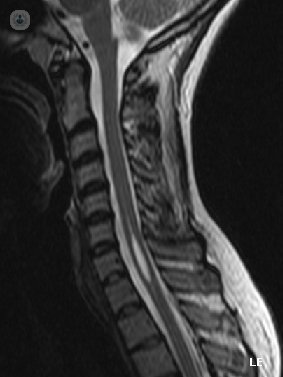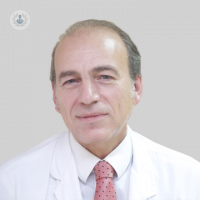Syringomyelia, spinal cord disease
Written by:Syringomyelia is an important pathology of spinal cord. The diagnostic and therapeutic approach should be quick and effective by the neurosurgeon, because the disease causes the bone is filled with liquid and can leave the patient disabled.

Syringomyelia: what it is and what causes
Syringomyelia is a disease of the spinal cord in which it is filled with liquid, forming a liquid collection compressing the spine from the inside out and can leave tetraparético or paraparético to a patient.
Syringomyelia occurs when there is a conflict of flow or pressure in the space of the spinal cord. In the embryonic period we have a central channel in the bone through which the spinal fluid. This channel closes before birth but certain diseases can not close or later in juvenile or adult life, can reopen.
When it occurs is filled with spinal fluid compresses. This damages the surrounding structures with:
- Muscular weakness
- Muscular atrophy
- twitching
- Liberation reflexes
- Loss of bladder or bowel control
- Different levels of loss of balance and sensitivity
Rarely get the disease to the brain stem (Medulla), denominating then Syringobulbia. This condition is very serious, because it can seriously compromise the patient's breathing and, if not act quickly, cause death.
List of syringomyelia with Arnold-Chiari syndrome
Syndrome Arnold-Chiari also corresponds to a condition where a defective development of the skull, a conflict of cerebrospinal fluid and its beat, that does not pass properly from the cranial spinal compartment occurs. In some of these cases dilatation of the cranial cavities cerebrospinal fluid (hydrocephalus) it occurs and, in others, occurs at the spinal level, dilating the ependymal canal (syringomyelia). In these cases it is associated Syringomyelia Syndrome Arnold-Chiari.
Treatment of syringomyelia
Syringomyelia that is not related to Arnold-Chiari syndrome can be caused by multiple factors: trauma, tumors, post - surgery, etc.. In some cases you can not identify any causal agent (idiopathic) and, in others, it may appear until more than 30 years after a serious back-lumbar (ascending syringomyelia) fracture, for example.
Where there is a clear causal factor, which will operate the first, and expect the resolution syringomyelia after. If not, the neurosurgeon must specifically involved the cavity created with its opening and place a silicone tube that runs from within the medullary cavity to the space surrounding the spinal (subarachnoid space) where empty the liquid and where reabsorbed. At other times it is passed to the peritoneum tube into the patient's abdomen, where it is also reabsorbed into the general circulation. Thus, the excess liquid and beat damped out of the bone, negating the spinal damage he produced fluid retention. This more than 50% of syringomyelia stop and even improve.
By contrast, syringomyelia associated with Chiari syndrome Arnold-usually not specifically addressed. With decompression of the foramen magnum in the skull base that is made in the Chiari is achieved open the hole passage of cerebrospinal fluid, which, in 70% of cases, and pressure is transmitted to the medullary cavity, which it is reduced or disappears.
Quality of life of patients with syringomyelia
For the Siringomielia not significantly deteriorate the bone should act with some speed in the early symptoms and intervene the patient. Although in early stages the cavity is not very long, today, with intraoperative ultrasound and neurophysiological monitoring, we can more easily find the way to the collection liquid and drain it out. This, at least, stop the process in early stage of deterioration and the patient maintain an acceptable quality of life, especially if the sphincters are preserved, as this is an important prognostic factor.


